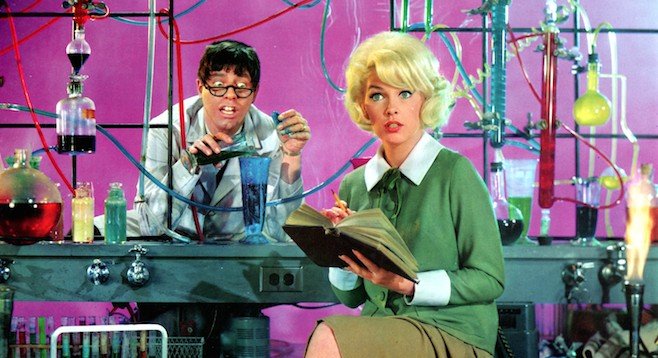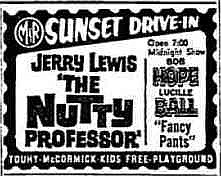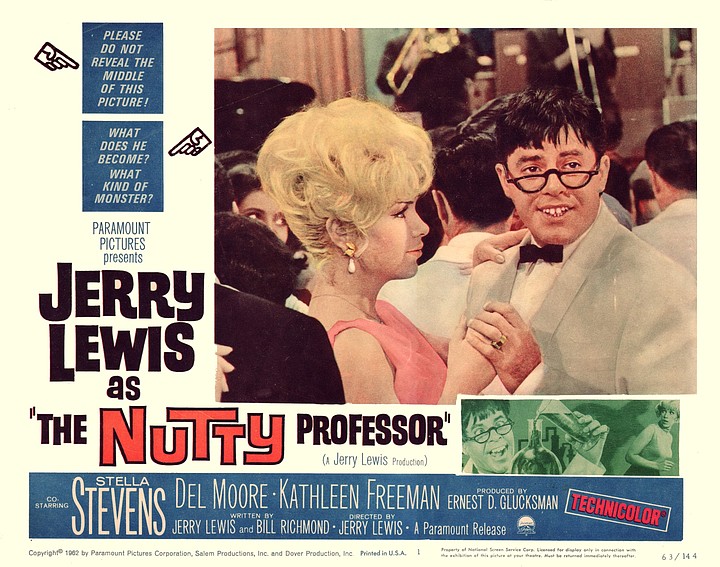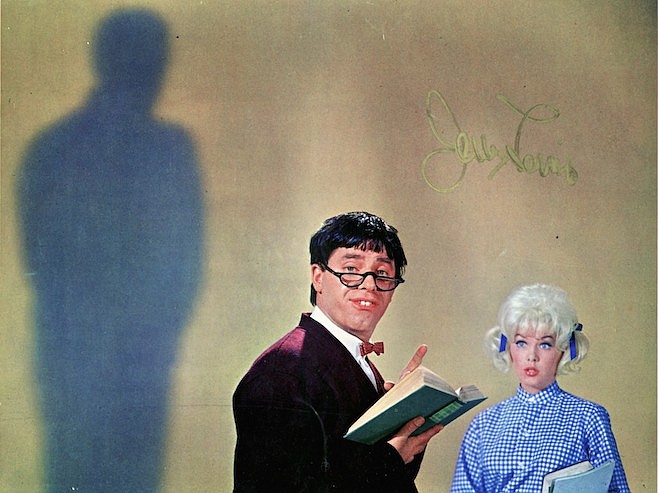 Facebook
Facebook
 X
X
 Instagram
Instagram
 TikTok
TikTok
 Youtube
Youtube

The remake of the 1963 Jerry Lewis comedy is not the most extreme, but perhaps the most literal illustration of the prevailing bigger-is-better philosophy. More exactly, fatter-is-better. Rather than depend on the rigors of performance, Eddie Murphy depends instead on a ton of foam-rubber latex as well as on a fantasy scene of <em>King Kong</em> proportions — and that's <em>before</em> his Jekyll-to-Hyde transformation from blubbery campus chemist to sleek streetwise scamp. Murphy, even at this late date, is not incapable of performance, and as proof he comes up with an assortment of funny voices for the hero's roomful of corpulent relatives, all played by Murphy himself under different depths of disguise. The voices might have been funnier, though, if we were not distracted by the continuous search to "find" the actor inside the padding. (We have to take it on faith that he's in there somewhere.) They would most certainly have been funnier if they had funny things to say. Closer, however, to the crux of the matter: what sense does it make, if such a question might be raised, to start off with an alien persona and then to bring out by artificial means Murphy's <em>familiar</em> one? Where's the surprise, the revelation, the discovery in that? What, to put it another way, is the relevance of fat and thin to Eddie Murphy? And lastly, is it only a coincidence that Jerry Lewis's best movie is also the one that <em>means</em> the most? (Gee. A comedy that <em>means</em>. What a concept!) The remake, directed by Tom Shadyac, piles on the makeup over a vacant emotional core, as if to conceal a mere and minor blemish. Thicker-is-better.
The Jerry Lewis original didn’t make it to DVD until almost six years after the Eddie Murphy remake hit store shelves in 1998. For years I dragged the remainder bins in search of Kelp, when all that came up was Klump.
July 25, 1996, is a day that I’ll never forget, and not because it was 20 years to the day that Dean and Jerry split. While in Chicago touring with Damm Yankees, Jerry was gracious enough to accept my invitation to be interviewed before my class (and a few hundred more students) at Columbia College.
The limo pulled up and out popped Jerry. “11:56,” he yelled, tapping his Cartier wristwatch to make sure I knew that he’d arrived ahead of schedule as promised. We stood in a makeshift dressing room below the stage waiting for the packed auditorium to finish watching The Nutty Professor. Something akin to a sonic boom set floorboards creaking and windows rattling.
“What the fuck was that?” asked a jounced Jerry. “Don’t you know by now?” I laughed. “That’s the sound of an audience showing their appreciation for one of your movies.”



Well, maybe not just one of his movies. TNP is the one Lewis films that even his staunchest detractors grudgingly give their approval. I have spent more of my adult life defending Jerry Lewis than all other artists combined. He’s #2 in line behind Jean-Luc Godard as our greatest living filmmaker. (Sorry, Marty.)
It’s long been my understanding that people either hate Jerry Lewis or dislike him intensely. I can almost come to terms with those who might not find his spastic antics funny. What I’ll never fathom is how someone can look at TNP or The Patsy, or The Ladies’ Man — hell, even Hardly Working — and not recognize a brilliant formalist at work.
No other comedic filmmaker, not Chaplin, not even Tati, knew how to wring gales of laughter through intuitive body placement in the frame quite like Jerry. His visual timing of a gag is exemplary, as evidenced by the heart-stopping orangutan-arms dumbbell schtick in TNP. One second off in either direction and the gag would have been toast. Ditto for Stella Stevens gliding center-frame down the college corridor as two doors on either side of her swing open to allow just enough room for her to slip through.
TNP is one of the most personal comedies ever made, particularly if you don’t buy into all the reductionist hype that surrounds its lead character’s alter ego. Lewis has always had a thing for schizophrenia, and Buddy Love is no more 100 proof Dean Martin than he is Adolf Eichmann, one of the first names Jerry mentions when asked who inspired the character. Buddy’s the evil twin of his creator — a brooding, egomaniacal entertainer, a perfectionist who demands that all eyes be focused on his marvelousness at all times. Lewis refused to allow his own children to watch the film until they came of age, and not for fear that they may look negatively upon their Uncle Dean.
It wasn’t the first time Robert Louis Stevenson’s Dr. Jekyll and Mr. Hyde was brought to the screen. Sure, John Barrymore was swingin’ in the dual role, as were the nutty Freddy March and marvelous Spencer Tracy. But nothing quite prepares you for the swingin’ nuttiness of Dr. Kelp and Mr. Love.
Admit it: the last time you viewed The Nutty Professor from beginning to end was at age seven while spending a rainy Saturday afternoon in front of the TV or as an adult too drunk to find the remote and change the channel when it played the 2 am slot on Encore.
You have three chances to see the freshly restored version, at Regal Escondido and Mira Mesa: Sunday, September 14 at 2 pm and Wednesday, September 17 at 2 pm and 7 pm. Don’t miss it!


The remake of the 1963 Jerry Lewis comedy is not the most extreme, but perhaps the most literal illustration of the prevailing bigger-is-better philosophy. More exactly, fatter-is-better. Rather than depend on the rigors of performance, Eddie Murphy depends instead on a ton of foam-rubber latex as well as on a fantasy scene of <em>King Kong</em> proportions — and that's <em>before</em> his Jekyll-to-Hyde transformation from blubbery campus chemist to sleek streetwise scamp. Murphy, even at this late date, is not incapable of performance, and as proof he comes up with an assortment of funny voices for the hero's roomful of corpulent relatives, all played by Murphy himself under different depths of disguise. The voices might have been funnier, though, if we were not distracted by the continuous search to "find" the actor inside the padding. (We have to take it on faith that he's in there somewhere.) They would most certainly have been funnier if they had funny things to say. Closer, however, to the crux of the matter: what sense does it make, if such a question might be raised, to start off with an alien persona and then to bring out by artificial means Murphy's <em>familiar</em> one? Where's the surprise, the revelation, the discovery in that? What, to put it another way, is the relevance of fat and thin to Eddie Murphy? And lastly, is it only a coincidence that Jerry Lewis's best movie is also the one that <em>means</em> the most? (Gee. A comedy that <em>means</em>. What a concept!) The remake, directed by Tom Shadyac, piles on the makeup over a vacant emotional core, as if to conceal a mere and minor blemish. Thicker-is-better.
The Jerry Lewis original didn’t make it to DVD until almost six years after the Eddie Murphy remake hit store shelves in 1998. For years I dragged the remainder bins in search of Kelp, when all that came up was Klump.
July 25, 1996, is a day that I’ll never forget, and not because it was 20 years to the day that Dean and Jerry split. While in Chicago touring with Damm Yankees, Jerry was gracious enough to accept my invitation to be interviewed before my class (and a few hundred more students) at Columbia College.
The limo pulled up and out popped Jerry. “11:56,” he yelled, tapping his Cartier wristwatch to make sure I knew that he’d arrived ahead of schedule as promised. We stood in a makeshift dressing room below the stage waiting for the packed auditorium to finish watching The Nutty Professor. Something akin to a sonic boom set floorboards creaking and windows rattling.
“What the fuck was that?” asked a jounced Jerry. “Don’t you know by now?” I laughed. “That’s the sound of an audience showing their appreciation for one of your movies.”



Well, maybe not just one of his movies. TNP is the one Lewis films that even his staunchest detractors grudgingly give their approval. I have spent more of my adult life defending Jerry Lewis than all other artists combined. He’s #2 in line behind Jean-Luc Godard as our greatest living filmmaker. (Sorry, Marty.)
It’s long been my understanding that people either hate Jerry Lewis or dislike him intensely. I can almost come to terms with those who might not find his spastic antics funny. What I’ll never fathom is how someone can look at TNP or The Patsy, or The Ladies’ Man — hell, even Hardly Working — and not recognize a brilliant formalist at work.
No other comedic filmmaker, not Chaplin, not even Tati, knew how to wring gales of laughter through intuitive body placement in the frame quite like Jerry. His visual timing of a gag is exemplary, as evidenced by the heart-stopping orangutan-arms dumbbell schtick in TNP. One second off in either direction and the gag would have been toast. Ditto for Stella Stevens gliding center-frame down the college corridor as two doors on either side of her swing open to allow just enough room for her to slip through.
TNP is one of the most personal comedies ever made, particularly if you don’t buy into all the reductionist hype that surrounds its lead character’s alter ego. Lewis has always had a thing for schizophrenia, and Buddy Love is no more 100 proof Dean Martin than he is Adolf Eichmann, one of the first names Jerry mentions when asked who inspired the character. Buddy’s the evil twin of his creator — a brooding, egomaniacal entertainer, a perfectionist who demands that all eyes be focused on his marvelousness at all times. Lewis refused to allow his own children to watch the film until they came of age, and not for fear that they may look negatively upon their Uncle Dean.
It wasn’t the first time Robert Louis Stevenson’s Dr. Jekyll and Mr. Hyde was brought to the screen. Sure, John Barrymore was swingin’ in the dual role, as were the nutty Freddy March and marvelous Spencer Tracy. But nothing quite prepares you for the swingin’ nuttiness of Dr. Kelp and Mr. Love.
Admit it: the last time you viewed The Nutty Professor from beginning to end was at age seven while spending a rainy Saturday afternoon in front of the TV or as an adult too drunk to find the remote and change the channel when it played the 2 am slot on Encore.
You have three chances to see the freshly restored version, at Regal Escondido and Mira Mesa: Sunday, September 14 at 2 pm and Wednesday, September 17 at 2 pm and 7 pm. Don’t miss it!
Comments